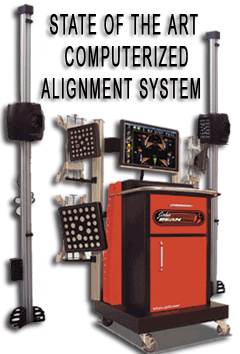Jeffersonville Vermont Automotive Computerized Alignment
What would happen if you gave an Olympic long-distance runner two different types of athletic shoes to run his next race? Chances are his performance would suffer. The same can be said about your car's driving potential if its alignment isn't correctly positioned. When vehicle alignment is not proportioned correctly, two issues may occur:
- Driving becomes more expensive
- Driving becomes more dangerous
Driving in a vehicle without proper alignment is an expensive enterprise. Not only does flawed alignment decrease gas mileage and tire life, it also adds stress to other vehicle components, including steering equipment and overall structural damage. Ideally, your vehicle's wheels should be perpendicular to the ground and parallel to each other. Adjusting the angles of the wheels so that they meet these criteria is how our service professionals ensure your vehicle is properly aligned.
| Driving in a vehicle without proper alignment is a dangerous idea. A car
that is out of alignment can pull or drift away from a straight road,
resulting in a possibly fatal situation. Excessive tire wear - another result
of bad car alignment—can lead to tire blow-outs and poor traction, which
also has potentially disastrous consequences. That is why it is imperative
you let our alignment experts make sure you're driving smoothly and safely. So, how does it happen? Your vehicle's alignment can be impacted by a variety of factors. An obvious indication that you require our computerized alignment service is a major or minor collision that results in physical damage to your vehicle's frame. Steering problems or the presence of uneven wear patterns on your tires are clear signs that demand immediate attention. But alignment problems don't only occur by collisions and accidents; problems can arise by something as small as driving over a pothole, or grazing over a curb. The following descriptions are symptomatic alignment variations you should look for in order to determine if you require our computerized alignment services. |
 |
Caster:
Caster is used to describe the angle of a steering pivot, as seen from the side of the vehicle and measured in degrees. Caster alignment plays a large role in evaluating the "feel" of steering and the stability of high-speed transportation. Three to five degrees of positive caster is typical for most vehicles, and lower angles for heavier vehicles are used to keep steering comfortable. A faulty caster angle will cause loose or difficult steering.
Camber:
Camber is the angle of the wheel in relation to a vertical direction (seen from the front or rear of the car). A negative camber measurement occurs when a wheel leans toward the chassis; a positive measurement points the wheel away from the car. An ideal camber angle assures optimal tire efficiency, proper steering control, and a precautionary "anti-roll" directive that engineers have adapted into vehicle designs to negate the effects of a body roll. A faulty camber angle will create pulling and tire wear.
Toe:
Like camber and caster, toe is measured by degrees and is another basic aspect of suspension tuning. When a pair of wheels are placed with their front edges pointed toward each other, the pair is defined as "toe-ins." If the front edges point away from each other, the pair is defined as "toe-outs." Essentially, a toe changes the distance between the front and back of the rear tires, and a faulty toe angle will wear down your tires.
I visited your shop and my alignment is now correct. What can I
expect now?
When your wheels are properly aligned, you'll get:
- Tires that last longer
- Easier steering
- Improved gas mileage
- Smoother ride
- Safer, more secure driving
Schedule an appointment or find out more about what we can do for your vehicle, contact us at 802-644-2858.
